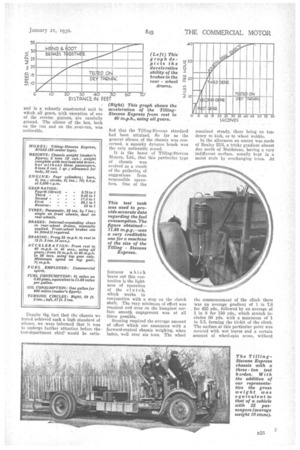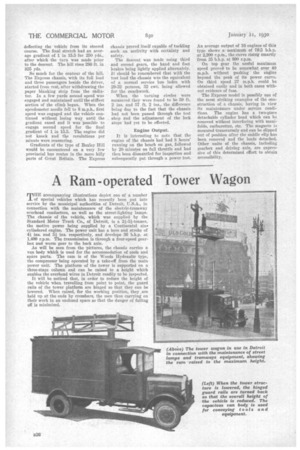A ROAD TRIAL
Page 50

Page 51

Page 52

If you've noticed an error in this article please click here to report it so we can fix it.
of the
TILLING.. STEVENSEXPRESS
ITOR several years one of the most ..12 popular passenger-carrying chassis has been the Express model manufactured by Tilliug-Stevens Motors, Ltd., St. Peter's Street, Maidstone. It is made in three types: forward control for 32 passengers, normal control for 30 passengers or forward control for 40 passengers. This test refers to the first-named type which, with a bus lighting set and 38-in. by 7-in. tyres, is priced at 1966. If desired, frontwheel brakes can be added for £35, servo operation being employed.
Having cleared the traffic of Maidstone, a halt was called to install 9 feel-consumption-test tank and a run of Si miles over a give-andtake road—en route to London—was then undertaken.
Top gear was used throughout, except when it was necessary to turn the vehicle after 4i miles had been covered. The route was representative of average bus-working conditions; 5.65 pints of petrol were used to cover the Si miles. During this test no coasting was allowed ; a cruising speed of 30 m.p.h. was maintained.
During the morning general tests were executed and it was found possible easily to restart upon a gradient of 1 in 6. The engine, which had a compression ratio of 5 to 1, demanded careful handling of the ignition lever, but pulled smoothly at all times. When driving in traffic the speed could be allowed to fall to 7* m.p.h. on top.
The chassis which we tested was equipped only with rear-wheel brakes. These are of the concentric .type, . the foot-brake shoes being in the outer drums and the hand-brake ones in the Inner drums. The leverages of the operating mechanism bad been well calculated and the effort required to bring to rest the vehicle, weighing approximately 61 tons, was pleasantly small, using only the foot brake.
Braking Tests.
During the retardation tests (the results of which are shown in a graph
reproduced in these pages) both hand and foot brakes were used in combination in order to show the maximum decelerative ability which could be called upon in case of emergency. The brakes operated sweetly and the only tendency, if the wheels were locked inadvertently due to too hard an application, was to travel forwards, not sideways.
Whilst on the question of road holding, we paid particular attention to the "weaving" of the frame, in the construction of which fitted bolts in reamed holes are used throughout. Two of the three blocks forming the test load were forward of the rear axle and one behind it. Naturally, the chassis flexed as one rear wheel rose above the level of the other, but the frame permitted only a very restrained action.
A rough test seat was mounted in the driver's cab upon the chassis and this was built rather high in order to accommodate a spare-parts box. This gave an extremely comfortable driving position, but raised the level of the driver's left hand somewhat above that which would obtain if a proper bbdy were fitted. The result was that, whilst it was very easy to change from first and third gears up to second and fourth, i.e., to make backward movements of the lever, it was not so easy to start the lever travelling forward. Little physical effort Was required and the gears themselves engaged quietly without the need for any particular care on the part of the driver in calculating the relative speeds of the
shafts. . • The gearbox is mounted amidships and is a robustly constructed unit in which all gears, with exception of one of the reverse pinions, are carefully ground. -The silence of the box, both on the run and on the over-run, was noticeable.
Despite thp fact that the chassis we tested achieved such a high standard of silence, we were informed that it was to undergo further attention before the test-department chief' would be antis
fied, that the Tilling-Stevens standard had been attained. So far as the general silence, of the chassis was concerned, a' squeaky dynamo brush was the only noticeable sound.
It is the boast of Tilling-Stevens Motors, Ltd., that this particular type of chassis was evolved as a result of the gathering of suggestions from responsible operators. One of the features which bears out this con tention is the lightness of operation of the clutch, which works in conjunction with a stop on the clutch shaft. The very minimum of effort was required and even on the bumpiest surface smooth engagement was at all times possible.
Steering required the average amount of effort which one associates with a forward-control chassis weighing, when laden, well over six tons. The wheel
remained steady, there being no tendency to kick, or to wheel wobble.
In the afternoon an ascent was made of Boxley Hill, a tricky gradient almost due north of Maidstone, having a very indifferent surface, usually kept in a moist state by overhanging trees. At the commencement of the climb there was an average gradient of 1 in 7.8 for 425 yds., followed by an average of 1 in 8 for 150 yds., which stretch includes 50 yds. with a maximum of 1 in 5.5, forming the tit-bit of the climb. The surface at this particular point was covered with wet leaves and a certain amount of wheel-spin arose, without
deflecting the vehicle from its steered course. The final stretch had an average gradient of 1 in 15.5 for 250 yds., after which the turn was made prior to the descent. The hill rises 280 ft. in 825 yds.
So much for the contour of the hill. The Express chassis, with its full load and three passengers beside the driver, started from rest, after withdrawing, the paper blanking strip from the radiator. In a few yards second speed was engaged and maintained until the stiffest section of the climb began. When the speedometer needle fell to 8 m.p.h., first speed was engaged and the vehicle continued without losing way until the gradient eased and it was possible to engage second speed for the final gradient of 1 in 15.5. The engine did not knock and the revolutions per minute were reassuring.
Gradients of the type of Bexley Hill would be encountered on a very few provincial bus routes in the more hilly parts of Great Britain. The Express chassis proved itself capable of tackling such an acclivity with certainty and safety.
The descent was made using third and second gears, the hand and foot brakes being lightly applied alternately. It should be remembered that with the test load the chassis was the equivalent of a normal service bus laden with 29-32 persons, 32 cwt. being allowed for the coachwork.
When the turning circles were measured they were found to be 59 ft. 2 ins. and 57 ft. 2 ins., the difference being due to the fact that the chassis had not been passed throngh the test shop And the adjustment of the lock stops • had yet to be effected.
Engine Output.
It is interesting to note that the engine of the chassis had had 8 hours' running on the bench on gas, followed by 20 minutes on full throttle and had then been dismantled for inspection and subsequently put through a power test. An average output of 10 engines of this type shows a maximum of 70.5 b.h.p. at 2,200 r.p.m., the curve rising smartly from 35 b.h.p. at 800 r.p.m.
On top gear the useful maximum speed proved, to be somewhat over 40 m.p.h. without pushing the engine beyond the peak of its power curve. On third speed 27 m.p.h. could be obtained easily and in both cases without evidence of fuss.
The Express model is possibly one of the most striking examples of the construction of a chassis, having in view its maintenance under service conditions. The engine has a two-piece detachable cylinder head which can be removed without interfering with manifolds, carburetter, etc. The magneto 18 mounted transversely and can be slipped out of position after the saddle clip has been removed and the leads detached. Other units of the chassis, including gearbox and driving axle, are expressive of this determined effort to obtain accessibility.




















































































































